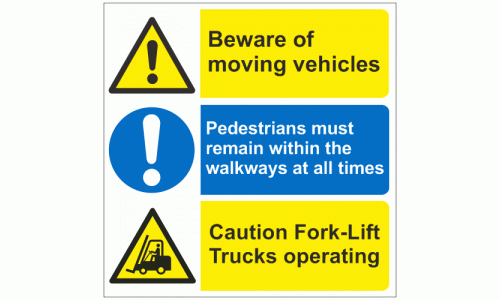Forklift Truck Safety Signs-- Shield Your Team with Reliable Safety Markings
Wiki Article
Trick Considerations for Creating Effective Forklift Safety And Security Signs
When designing reliable forklift safety and security indicators, it is vital to think about a number of fundamental factors that jointly make certain ideal exposure and clarity. Strategic positioning at eye degree and the use of resilient products like aluminum or polycarbonate further add to the durability and effectiveness of these indicators.Shade and Contrast
While designing forklift safety and security indicators, the option of color and comparison is vital to guaranteeing presence and efficiency. Colors are not just visual aspects; they serve critical practical purposes by sharing particular messages quickly and decreasing the danger of crashes. The Occupational Security and Health Management (OSHA) and the American National Criteria Institute (ANSI) give guidelines for using shades in safety indicators to standardize their significances. For instance, red is normally made use of to denote instant danger, while yellow signifies caution.Effective contrast between the history and the text or signs on the indicator is similarly vital. High comparison guarantees that the indication is legible from a range and in varying lighting conditions. Black message on a yellow history or white text on a red background are mixes that stand out plainly. Additionally, making use of reflective products can boost visibility in low-light environments, which is typically a consideration in stockroom settings where forklifts operate.
Utilizing suitable color and contrast not just sticks to regulative criteria yet additionally plays a vital role in preserving a risk-free workplace by making certain clear interaction of dangers and directions.

Font Style Size and Design
When creating forklift security indications, the option of font style dimension and style is important for guaranteeing that the messages are understandable and rapidly recognized. The primary goal is to boost readability, particularly in environments where fast details processing is necessary. The font size need to be large enough to be reviewed from a range, accommodating differing sight conditions and guaranteeing that employees can understand the sign without unnecessary stress.A sans-serif typeface is typically advised for safety indicators due to its tidy and straightforward appearance, which improves readability. Font styles such as Arial, Helvetica, or Verdana are usually chosen as they do not have the elaborate information that can obscure important information. Uniformity in font design across all safety and security indicators help in developing an attire and professional look, which further reinforces the significance of the messages being conveyed.
Additionally, emphasis can be achieved with tactical usage of bolding and capitalization. By very carefully choosing suitable font style dimensions and designs, forklift safety indications can efficiently connect critical safety and security information to all personnel.
Positioning and Exposure
Guaranteeing optimum positioning and exposure of forklift security indications is critical in industrial settings. Correct sign positioning can substantially decrease the danger of accidents and enhance total office security. Indications should be positioned at eye degree to ensure they are quickly noticeable by operators and pedestrians. This typically indicates positioning them between 4 and 6 feet from the ground, relying on the average height of the labor force.
Illumination problems also play a vital role in visibility. Signs ought to be well-lit or made from reflective materials in dimly lit areas to guarantee they show up whatsoever times. Using contrasting shades useful reference can even more boost readability, especially in atmospheres with differing light problems. By meticulously taking into consideration these elements, one can make sure that forklift security signs are both reliable and visible, therefore cultivating a much safer working atmosphere.
Product and Toughness
Choosing the appropriate materials for forklift security indications is crucial to guaranteeing their longevity and effectiveness in industrial environments. Provided the severe problems typically encountered in stockrooms and producing facilities, the products chosen must withstand a selection of stress factors, including temperature fluctuations, dampness, chemical exposure, and physical impacts. Sturdy substrates such as aluminum, high-density polyethylene (HDPE), and polycarbonate are popular choices because of their resistance to these components.Aluminum is renowned for its effectiveness and corrosion resistance, making it a superb selection for both interior and outside applications. HDPE, on the other hand, offers phenomenal impact resistance and can endure long term exposure to rough chemicals without weakening. Polycarbonate, known for its high effect toughness and clarity, is commonly used where presence and longevity are extremely important.
Just as essential is the kind of printing used on the signs. UV-resistant inks and protective coatings can substantially enhance the life expectancy of the signage by protecting against fading and wear triggered by prolonged direct exposure to sunlight and other ecological elements. Laminated or screen-printed surface areas offer added layers of protection, making certain that the essential security details stays legible gradually.
Buying high-grade products and durable production refines not only extends the life of forklift safety and security indicators yet also reinforces a society of safety and security within the workplace.
Conformity With Rules
Following regulatory criteria is vital in the layout and release of forklift safety and security indicators. Compliance guarantees that the indications are not just reliable in conveying vital safety and security details but also meet lawful obligations, therefore reducing possible responsibilities. Various organizations, such as the Occupational Safety and Health And Wellness Administration (OSHA) in the United States, give clear guidelines on the requirements of security signs, including color systems, message dimension, and the incorporation of globally identified icons.To adhere to these regulations, it is necessary to carry out a complete testimonial of appropriate criteria. For circumstances, OSHA mandates that safety and security indications should be visible from a range and include details shades: red for risk, yellow for caution, and eco-friendly for safety instructions. In addition, sticking to the American National Criteria Institute (ANSI) Z535 collection can better improve the effectiveness of the signs by systematizing the style elements.
Moreover, routine audits and updates of security indications need to be done to make certain recurring conformity with any kind of changes in regulations. Involving with certified security specialists throughout the layout this link stage can additionally be valuable in ensuring that all regulatory demands are met, and that the indicators offer their desired purpose successfully.
Conclusion
Designing reliable forklift safety indications calls for cautious interest to color comparison, typeface dimension, and design to ensure ideal exposure and readability. Strategic placement at eye level in high-traffic locations improves awareness, while the use of sturdy materials guarantees durability in numerous environmental conditions. Adherence to OSHA and ANSI standards systematizes safety messages, and including reflective products enhances exposure in low-light scenarios. These considerations collectively add to a safer working setting.Report this wiki page